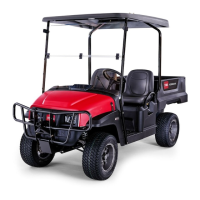Workman MDX--D Page 6 -- 41 Chassis
Bleed Brake System
IMPORTANT: To prevent contamination of t he brake
system, make sure to clean components before dis-
assembly.
1. Connect a suitable transparent hose to bleeder valve
on front brake caliper (Fig. 31) or rear wheel brake cylin-
der (Fig. 32). Submerge other end of hose in a glass
container partially filled with clean brake fluid.
2. Have a second person pump brake pedal several
times, then hold pedal down firmly.
3. With pedal firmly depressed, open bleeder valve of
brake until pedal fades to floor. Close bleeder valve be-
fore releasing pedal.
4. Repeat procedure until a continuous flow of brake
fluid, with no air bubbles, is released from bleeder valve.
Make sure fluid level is maintained in brake fluid res-
ervoir at all times.
5. When brake bleeding is completed, torque caliper
bleed valve as follows:
A. Torque caliper bleed valve on front brakes from
54 to 66 in--lb (6.2 to 7.4 N--m).
B. Torque caliper bleed valve on rear brakes to 38
in--lb (4.3 N--m).
6. Repeat steps 1 to 4 for other front calipers and rear
brake cylinders.
CAUTION
After servicing the brakes, always check the
brakes in a wide open, level area that is free of
other persons and obstructions.
7. After bleeding of b rakes is completed, test vehicle to
make sure brakes are operating correctly and brake
pedal is solid.
1. Front caliper (LH shown)
2. Banjo bolt
3. Bleed valve
Figure 31
1
2
3
1. Rear brake (LH shown)
2. Banjo bolt
3. Bleed valve
Figure 32
1
2
3
Chassis

